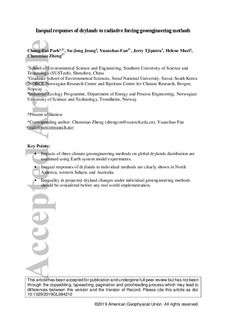| dc.contributor.author | Park, Chang-Eui | |
| dc.contributor.author | Jeong, Su-Jong | |
| dc.contributor.author | Fan, Yuanchao | |
| dc.contributor.author | Tjiputra, Jerry | |
| dc.contributor.author | Muri, Helene | |
| dc.contributor.author | Zheng, Chunmiao | |
| dc.date.accessioned | 2019-12-02T09:13:56Z | |
| dc.date.available | 2019-12-02T09:13:56Z | |
| dc.date.created | 2019-11-28T18:03:59Z | |
| dc.date.issued | 2019 | |
| dc.identifier.issn | 0094-8276 | |
| dc.identifier.uri | http://hdl.handle.net/11250/2631202 | |
| dc.description.abstract | Climate geoengineering has the potential to reduce global warming. However, the nonlinear responses of Earth's large‐scale circulation to climate geoengineering can exacerbate regional climate change, with potential inequality risks. We show noticeable inequality in the responses of drylands when three radiative forcing geoengineering (RFG) methodologies – cirrus cloud thinning (CCT), marine sky brightening (MSB), and stratospheric aerosol injection (SAI) – individually reduce the radiative forcing of the Representative Concentration Pathway 8.5 (RCP8.5) scenario using a set of the Norwegian Earth system model (NorESM1‐ME) experiments. In North America, CCT and SAI alleviate drylands expansion, whereas, drylands expand further under MSB. CCT induces significantly wetter conditions over the western Sahel. Wetting over Australia is enhanced and prevented by MSB and SAI, respectively. Our results suggest spatially inequal distributions of benefits and harms of individual RFGs on the projected distribution of drylands, which should be considered before any real‐world application of such RFGs. | nb_NO |
| dc.language.iso | eng | nb_NO |
| dc.publisher | American Geophysical Union (AGU) | nb_NO |
| dc.title | Inequal responses of drylands to radiative forcing geoengineering methods | nb_NO |
| dc.type | Journal article | nb_NO |
| dc.type | Peer reviewed | nb_NO |
| dc.description.version | acceptedVersion | nb_NO |
| dc.source.journal | Geophysical Research Letters | nb_NO |
| dc.identifier.doi | 10.1029/2019GL084210 | |
| dc.identifier.cristin | 1754096 | |
| dc.description.localcode | © 2019. This is the authors' accepted and refereed manuscript to the article. The final authenticated version is available online at: https://doi.org/10.1029/2019GL084210 | nb_NO |
| cristin.unitcode | 194,64,25,0 | |
| cristin.unitname | Institutt for energi- og prosessteknikk | |
| cristin.ispublished | true | |
| cristin.fulltext | postprint | |
| cristin.qualitycode | 2 | |
